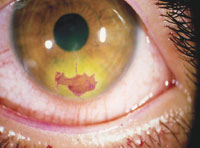New antivirals needed in ophthalmic pipeline, clinician says
Existing antiviral agents are decades old, yet pharmaceutical companies are investing in more lucrative ‘lifestyle’ diseases.
WAILEA, Hawaii — The pharmaceutical industry should be devoting more energy and resources to developing antiviral agents in order to ensure the future availability of effective vaccines and treatments, according to an ophthalmic virologist.
Jerold S. Gordon, MD, from The Campbell Laboratory, said he wants an increased commitment on the part of ophthalmic pharmaceutical companies to see that new agents become a reality.
He said ocular viruses such as herpes simplex virus-1 (HSV-1), herpes zoster, adenovirus and cytomegalovirus receive relatively little attention and resources from pharmaceutical companies compared to the aggressive funding for high-profile viruses such as HIV, the SARS Coronavirus and the H5N1 bird flu virus.
“Today there are many viruses for which there is an ambitious effort to develop antivirals,” Dr. Gordon said at Hawaiian Eye 2006. “At a conference in China [earlier this year], some $1.9 billion has been committed to finding ways of preventing a possible global [bird flu] pandemic.”
Meanwhile, he said research and development money for ophthalmic antiviral agents has practically dried up, despite the fact that current drugs are aging. Even the newer drugs, such as Famvir (famciclovir, Novartis) and Valtrex (valacyclovir, GlaxoSmithKline) are already 12 years old, he noted.
Drugs that were groundbreaking when they first came out have come to be seen as the gold standard, such as trifluiridine and acyclovir, which have been around for 26 and 23 years, respectively, he said.
Interest in developing new antivirals for ophthalmic use, according to Dr. Gordon, is limited by the fact that the pharmaceutical industry does not see a compelling need because the existing agents are still effective. He surmised that companies view the market as relatively narrow and feel there is limited financial return. Compounding this is the fact that clinical trials for new antivirals are “challenging and expensive,” he said.
No compelling need
“The truth of the matter is that current antivirals remain effective,” he said. “They target the DNA of the virus and do not allow time for resistance to form.”
Antivirals are less likely to lose their effectiveness, especially in immunocompetent patients, Dr. Gordon pointed out. In contrast, bacteria will almost always develop resistance to antibiotics following worldwide usage. In part, this has to do with the protective mechanism of herpetic latency in which, upon reactivation, the latent ganglionic virus will almost always be susceptible to the antiviral at the peripheral site of replication.
Dr. Gordon pointed out that HSV-1 antiviral resistance is virtually non-existent, even though the virus has been exposed to some 2.3 million kg of combined antiviral agents within the past 20 years.
A patient’s failure to respond to antiviral therapy is usually due to non-compliance, not to resistance, he added.
Limited market, decreased return
|
Image: Gordon JS |
Another possible explanation for the lack of interest in developing new ophthalmic antivirals is a perceived lack of return on the investment. The world’s top selling drugs right now are oriented toward chronic diseases or so-called “lifestyle” diseases that are viewed as more lucrative than anti-infectives or antivirals.
“Last year, the combined sales for Viagra, Cialis and Levitra passed $3 billion,” he said.
However, Dr. Gordon said there is potential for return in the form of newer antiherpetic antivirals that are cheaper, can be administered in drop form and require infrequent dosing. He added that the first antiviral to treat adenoviral ocular infections would be an important breakthrough that would reduce patient suffering and economic losses around the world.
Historically, Dr. Gordon added, that the major pharmaceutical manufacturers have developed drugs and licensed them to the ophthalmic pharmaceutical companies, who in turn market them to ophthalmologists.
However, about 5 years ago, many of these manufacturers stopped developing anti-infective agents, Dr. Gordon said. Now it is questionable whether smaller companies are equipped to fill that role, he said.
“The burden falls on the ophthalmic pharmaceutical [companies] to guarantee that we will have topical antibiotics and antivirals to treat our patients in the future,” he said.
Alternative approaches
Vaccines represent the most promising alternative to antiviral agents, Dr. Gordon said. While there are currently no approved vaccines against HSV-1 or HSV-2, a handful of vaccines are under development for genital herpes.
In contrast, Varivax (varicella virus live, Merck) is already in use worldwide against Varicella, or chickenpox.
Other alternative approaches include antimicrobial peptides, which Dr. Gordon described as “nature’s drugs.”
In existence for more than 2.6 billion years, peptides form part of the innate immunity of the eye and skin surfaces, he said. They are effective against bacteria, viruses, fungi and parasites.
“The challenge for ophthalmic development is toxicity, stability and formulation,” Dr. Gordon said.
The same challenges apply to the development of immunomodulatory agents for treating immunogenic herpetic stromal keratitis and iridocyclitis. Lote-prednol and COX-2 inhibitors have been shown to be effective in animals and could be a part of the antiviral armamentarium in the future, Dr. Gordon said.
Yet these drugs that “work in a test tube” are far from a guarantee of clinical success, he cautioned.
“We need a commitment from the ophthalmic pharmaceutical companies to completely develop the next generation of ophthalmic antivirals,” he said.
For more information:
- Jerold S. Gordon, MD, can be reached at the University of Pittsburgh, Room 1023, 203 Lothrop St., Pittsburgh, PA 15213; 412-647-2212; fax: 412-647-5119; e-mail: gordonjs@upmc.edu. Dr. Gordon has no direct financial interest in the products mentioned, nor is he a paid consultant for any of the companies mentioned.
- Lauren Wolkoff is Managing Editor of OSN Latin America and Japan editions.

